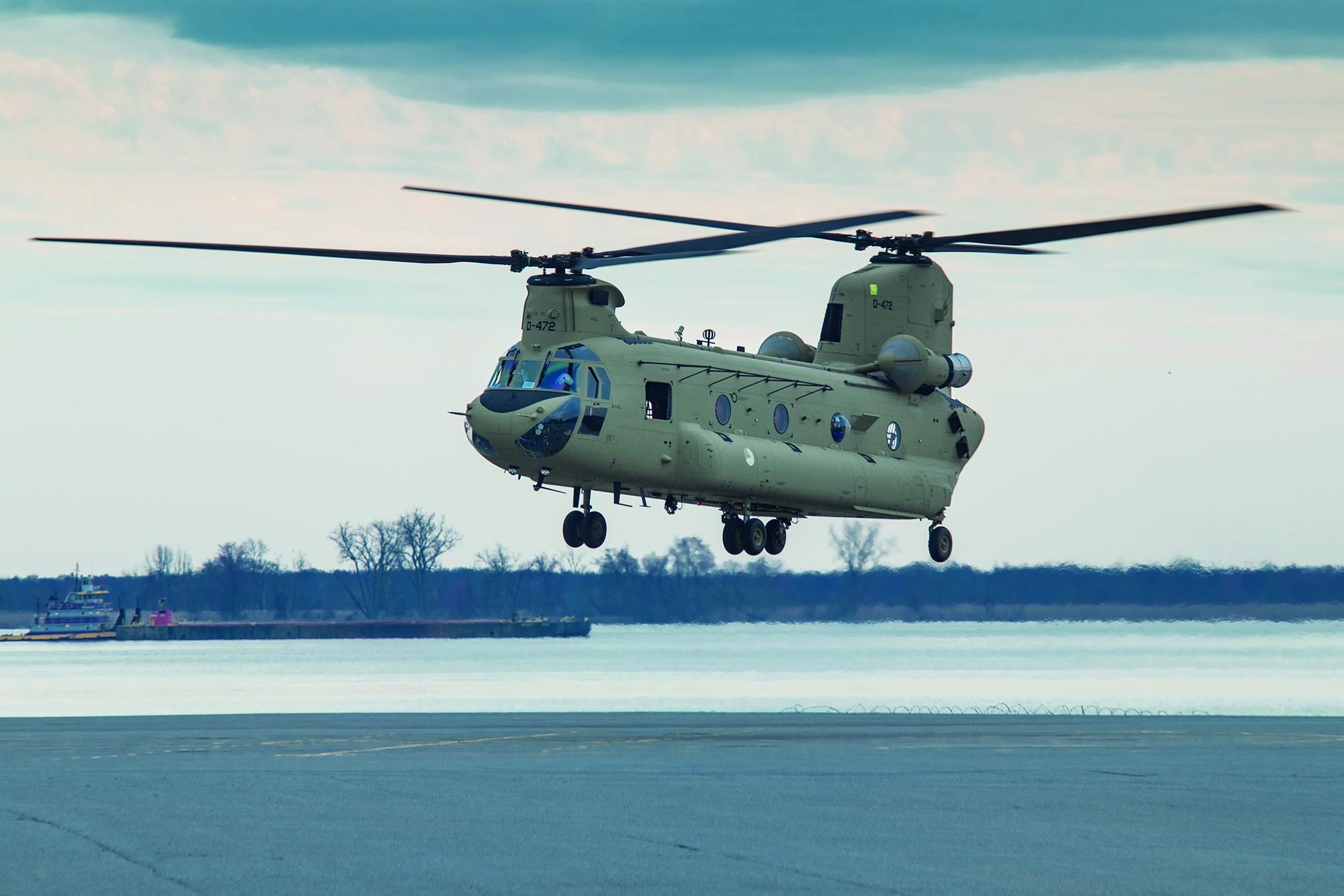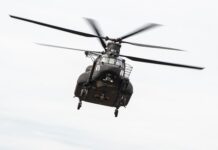The UK, the Netherlands and Spain are enhancing their fleets of this iconic cargo helicopter while Boeing seeks new customers in Europe with Germany, Switzerland and Norway in the frame.
The Boeing CH-47 CHINOOK helicopter serves the armed forces of 19 countries around the world. Among those nations there are five European NATO allies which are currently upgrading or purchasing new units of this twin-engine, tandem rotor and heavy-lift helicopter. The CHINOOK can fly at a maximum speed of 302 km/h and carry payloads greater than 9,525 kg.
United Kingdom
Boeing has just been awarded a contract worth US$2Bn for 14 H-47 Extended Range aircraft as well as engines, machine guns, radar and missile-jamming equipment for the choppers, according to officials and documents. The UK will be the first international operator of a Block II CHINOOK. Deliveries are scheduled to start in 2026 and be completed in 2030.
This will give the RAF more versatility to execute the domestic and international heavy-lift missions that only the CHINOOK can facilitate. “These CHINOOKs are the future of heavy-lift, built on an existing foundation of advanced capability and life cycle affordability,” said Andy Builta, Boeing vice president and H-47 programme manager. “This contract for Block II aircraft sets the stage for the next 60 years of CHINOOK excellence on the battlefield.”
This contract includes:
- T-55-GA-714A engines
- embedded GPS inertial navigation units
- missile warning systems
- radio-frequency counter-measures
- multi-mode radars
- electro-optical sensor systems
- M-134D-T mini guns
- M240H machine guns
Boeing maintains the UK’s existing fleet of 60 CHINOOK helicopters with 450 jobs across the country.
The Netherlands
Boeing and The Netherlands Ministry of Defence signed an agreement in 2017 that upgraded the Royal Netherlands Air Force (RNLAF) CHINOOK helicopters to the latest F-model configuration, ensuring commonality of systems for their entire fleet of 20 F-model CHINOOKs. Deliveries began in April 2020.
The 20 CH-47F CHINOOKs will be a fleet equipped with the same state-of-the-art technology as the US Army, including digital automatic flight controls, a fully-integrated Common Avionics Architecture System (CAAS) glass cockpit, advanced cargo handling capabilities and improved self-protection equipment. The common configuration leads to lower overall life cycle costs.
The Government of the Netherlands also requested support for the RNLAF CH-47 training programme, to include:
- fuel
- base operating support
- facilities
- publications and technical documentation
- pilot training
- personnel training
- training equipment
- weapon systems and software support
- other related elements of logistical and programme support
Spain
Boeing is working to modernise the Spanish fleet of 17 CH-47D CHINOOKs to the newest CH-47F configuration, adding features such as the digital automatic flight control system, common avionics architecture system and advanced cargo handling to align the country’s fleet with those of other nations. This is a €819M contract and deliveries are expected to begin this year and be completed in 2025.
The Spanish Government requested to buy the 17 CH-47Fs with 21 Common Missile Warning Systems (CMWS) AN/AAR-57A(V)8, 42 Embedded Global Positioning Systems (GPS) and Inertial Navigation Systems (INS).
Also included is:
- mission equipment
- hardware
- services required to implement customer-unique modifications
- communication
- Aircraft Survivability Equipment (ASE)
- navigation equipment including AN/ARC-231 multi-mode radios
- AN/ARC-201D SINCGARS radios
- AN/ARC-220 High Frequency (HF) Radio
- Identification, Friend or Foe (IFF)
- AN/AAR-57A(V)8
- Radar Signal Detecting Set (RSDS)
- AN/APR-39A(V)1
- special tools and test equipment
- ground support equipment
- airframe and engine spare parts
- technical data
- publications
- MWO/ECPs
- technical assistance
- transportation of aircraft and training
- other related elements of logistics and programme support
Italy
Boeing and Leonardo Helicopters have delivered all 16 new build ICH-47F model CHINOOKs to the Italian Army Aviation unit after an agreement signed in 2009. “We remain in a collaborative agreement with Leonardo for the support of the Italian CHINOOK fleet.” Boeing sources told ESD. That contract was worth US$1.23Bn.
Greece
The Hellenic Army retains a fleet of 25 CH-47D models in various configurations. There are no plans to upgrade this fleet yet.
Possible New Customers in Europe
According to Boeing, multiple global defence forces are currently expressing high interest in the H-47. This includes Foreign Military Sale (FMS) and Direct Commercial Sale (DCS) opportunities with existing customers seeking to expand the size and capability of their current fleet, as well as new customers like Germany, Switzerland and Norway looking to transform their heavy-lift capabilities for the next several decades.
“With more than six million flight hours and 950 aircraft in an actual combat operational environment – not in testing – the CHINOOK has an established global supply base for unrivaled affordability, around-the-clock part availability, immediate interoperability and streamlined aircraft maintenance and training procedures, as the US Army has several CHINOOKs stationed in Europe”, Boeing told ESD.
The Future: Block II Programme
What can we see in the future modernisation process? There are a number of ongoing efforts that continue to impact the evolvement of the CHINOOK fleet. The US continues their modernisation efforts with the Block II programme, which sets the stage for the next 60 years of CHINOOK excellence on the battlefield.
The configuration introduces the new Advanced CHINOOK Rotor Blade to provide even more lift capability to the aircraft. It also features a robust 54,000-pound airframe that enables the aircraft to carry heavier loads, a new fuel system to better manage weight and mission length, a new drivetrain to give more power to the rotor system, and a new electrical system.
“We’ve also brought digital capabilities into the aircraft with how we designed the new airframe for a larger engine, and how we developed the new electrical system. Our digital capabilities, as evidenced on programmes like the T-7A RED HAWK and F-15EX EAGLE II, have also played a critical role in the simulators, allowing us to make faster improvements to mission systems, reduce pilot workload and make the overall life cycle cost even more affordable”, a source of the US company said.
As it pertains to US allies, Boeing has a history of providing CHINOOKs that are uniquely tailored to meet the customer’s capability requirements at minimum cost.
“With the ability to leverage advanced, mature technologies from the US and international CHINOOKs, we are confident that the CHINOOK is the lowest risk, most affordable solution. We’re constantly talking with new and existing operators about the best way to do that, and we are confident that we will be able to offer some or all of the capabilities involved in the Block II programme to our international customers”.
Case-by-Case Solutions
Those decisions will be made on a case-by-case basis based on customer requirements.
“We pride ourselves in delivering CHINOOKs that are designed to meet each individual operator’s most challenging missions”, Boeing underlines.
For example, years ago the Royal Canadian Air Force needed a heavy-lift helicopter with additional capability to meet the country’s demanding operational and environmental requirements. As a result, Boeing modified the Canadian CHINOOKs with unique radar systems and long-range fuel tanks, allowing the aircraft to fly twice as far as previous models. This has enabled the CHINOOK to operate across a wider range of environments and has proven particularly important for missions in Canada’s vast northern regions. This approach is utilised by multiple international customers to meet their specific mission requirements and operational demands.












